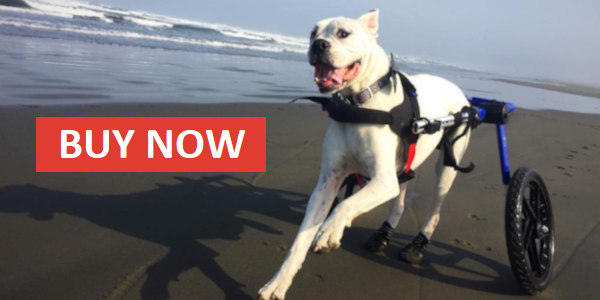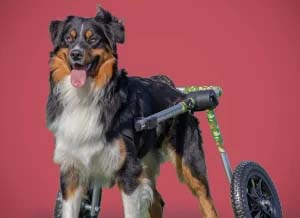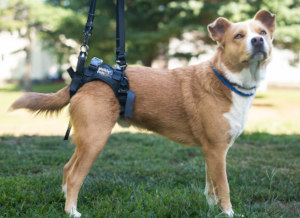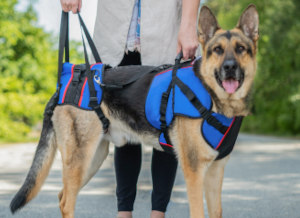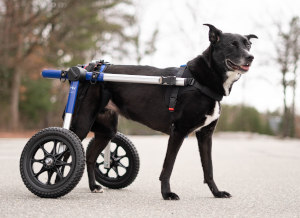
As a dog ages, it may slow down and begin to lose leg strength, but that doesn’t mean your dog can regain their strength. As an old dog’s legs weaken, the loss of mobility can have a detrimental effect on its entire life. Dogs that can no longer fully support themselves may change how they walk or stand and may stress different body parts. For example, a weak hind end may cause a dog to hunch their back or put more weight on its front legs, leading to even more joint pain.
Luckily, there are things you can do to help your dog to build up strength in its back legs and help them stay active.
How to Help an Old Dog Regain Leg Strength
Introduce a dog wheelchair into its daily routine
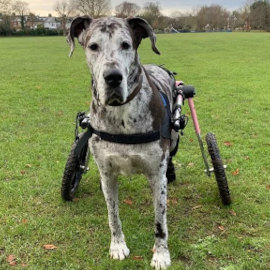
A dog wheelchair supports a dog’s back legs allowing them to stand in a natural upright position. Additionally, mobility carts reduce the pressure a pet places on its hind end, making it easier for them to move, which is vital for a senior dog’s health. When a dog becomes sedentary, they are at risk for rapid weight gain and muscle loss. Both of which are incredibly challenging to correct in older dogs. Age-related mobility loss may never be completely reversed in an older dog, but exercise can help slow the progression of the weakness. Therefore, a dog wheelchair is critical in keeping a senior dog active. Through continued exercise, an older pet can maintain a healthy weight, avoid obesity, and lessen muscle loss while improving their overall quality of life.
Taking your dog for a walk is a great way to help them regain strength in its back legs. An older dog may not have the stamina it had when it was younger. A wheelchair is a great way to give your dog support on their daily walk.
Keep your dog healthy
Annual wellness checks are critical as a dog gets older, many vets will recommend their older clients come in twice yearly. During a wellness exam, the vet is able to detect early signs of various geriatric conditions, assess the dog’s overall health, and ensure that the dog is still stable. In addition, checkups are vital to catching disease and mobility loss at the earliest stages when they are the most easily treated. Finally, for older dogs who have already shown signs of weakness, regular veterinary visits give your vet time to check your dog’s progress and watch for signs of worsening (or improvement).
Another important step to keep a senior dog healthy is keep them at a healthy weight, which can mean losing weight in an overweight dog or gaining weight if necessary. Weight fluctuations are typical in older dogs, but feeding seniors the right food (and the right amount) can improve their health and mobility. Talk to your veterinarian about your best friend’s dietary needs and whether or not a daily joint supplement would be beneficial.
Consider physical therapy
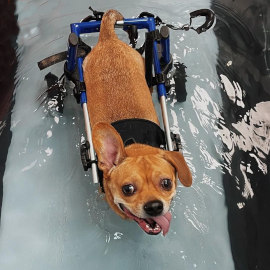
Physical therapy aims to reduce a dog’s pain, improve mobility, and rebuild hind leg strength. However, it’s important to know that rehab is a slow process and takes patience and time to see results.
A wide variety of exercises and techniques can help senior dogs, including massage, hydrotherapy, laser therapy, acupuncture, and structured exercise, to name a few. Your dog’s canine rehab practitioner will develop a plan that will include different therapeutic modalities combined with stretching and strengthening exercises catered to your dog’s condition. There is no “one size fits all” when it comes to rehabilitation – each case is different, and every dog will need a different treatment plan.
Swimming is a low-impact exercise that is highly beneficial for older dogs. When a dog swims, the water makes them buoyant, allowing it to move easily without pain or straining its joints.
Your Dog’s Mobility Matters
Improving a senior dog’s mobility matters. With the addition of a dog wheelchair, an inability to walk unassisted no longer means a dog needs to be put down. By combining proper veterinary care, with rehabilitation and a dog wheelchair a dog can help your best friend to regain it’s leg strength and live a long, happy (and active!) life.
